
Navanax inermis
(Cooper, 1863)
Order: CEPHALASPIDEA
Family: Aglajidae
DISTRIBUTION
From Monterey Bay, California to Laguna Manuela, Mexico. Also throughout the Gulf of Mexico.
PHOTO
Big Fisherman Cove, Wrigley Institute, Catalina Island, Los Angeles County, California, USA. 26-27 May 2001, 5-8 m depth. Photo: Daniel Geiger
Navanax inermis is probably the largest aglajid growing to at least 22cm in length. It is dark brown to black with a pattern of cream to yellow longitudinal lines, sometimes broken, and sometimes replaed by a close pattern of spots. The parapodia have an orange line along the edge, and an inner line of bright blue spots or dashes. The pallial lobes at the back of the posterior shield are relatively large and taper to a point.
In nature, Navanax inermis feeds on other sea slugs - such as bubble shells and sometimes nudibranchs. On rocky shores it tends to feed on nudibranchs such as Hermissenda crassicornis, Polycera atra and Dirona picta, while on sheltered muddy or sandy bottoms it feeds on bubble shells such as Haminoea virescens and Bulla gouldiana.
Anatomically Navanax shows no difference from the related genus Aglaja and I suggested many years ago that they should be synonymised. However the name Navanax persists in the popular literature. Species of aglajids like all opisthobranchs are hermaphrodite. In this family the penis is on the right side of the head while the genital opening is on the right side at the rear of the body. To mate, the partner acting as the male has to approach the "female" from behind. Often chains of three or more mating animals will form with those in the middle acting as male and female simultaneously. SEE Reggie Northern Californian Underwater Photographic Society website
Dr Rhanor Gillette's lab has a movie showing Navanax inermis feeding on an aeolid. This shows that like the aglajid genera Melanochlamys and Chelidonura, it feeds by using the buccal bulb as a suction pump. See also Bill Wright's message #16251 reporting Navanax eating Aplysia californica.
References:
• Cimino, G., Crispino, A., Sodano, G. & Spinella, A (1987) Alchilpiridine ed alchilbenzeni da Opistobranchi Bullomorfi: composti relazionati ai feromoni di allarme del Navanax inermis. Atti del XVII Convegno Nazionale della Divisione de Chimica Organica, Societa Chimica Italiana.
• Fenical, W., Sleeper, H.L., Paul, V.J., Stallard, M.O. & Sun, H.H. (1979) Defensive chemistry of Navanax and related opisthobranch molluscs. Pure and Applied Chemistry, 51: 1865-1874.
• Leonard, J.L. & Lukowiak, K .(1984) An ethogram of the sea slug, Navanax inermis (Gastropoda, Opisthobranchia). Z Tierpsychol, 65: 327-345.
• Leonard, J.L. & Lukowiak, K. (1985) Courtship, copulation, and sperm trading in the sea slug, Navanax inermis (Opisthobranchia: Cephalaspidea). Can. J. Zool., 63: 2719-2729.
•Paine, R.T. (1963) Food Recognition and Predation on Opisthobranchs by Navanax inermis. The Veliger, 6(1): 1-9.
•Paine, R.T. (1965) Natural History, Limiting Factors and Energetics of the opisthobranch Navanax inermis. Ecology, 46(5): 603-619.
• Rudman, W.B. (1974) A comparison of Chelidonura, Navanax and Aglaja with other genera of the Aglajidae (Opisthobranchia, Gastropoda). Zoological Journal of the Linnean Society, 54(3): 185-212.
• Sleeper, H.L., Paul, V.J. & Fenical, W. (1980) Alarm pheromones from the marine opisthobranch Navanax inermis. J. Chem. Ecol., 6(1): 57-70.
• Sleeper, H.L. & Fenical, W. (1977) Navenones A-C: Trail breaking alarm pheromones from the marine opisthobranch Navanax inermis. Journal of the American Chemical Society, 99: 2367-2368.
• Spinella, A., Alvarez, L.A., Crispino, A., Marin, A., Villani, G. & Cimino, G. (1992) Chemical signals in some Cephalaspidean molluscs. Abstracts, 11th International Malacological Congress, Siena 1992: 289-290.
Rudman, W.B., 2003 (April 29) Navanax inermis (Cooper, 1863). [In] Sea Slug Forum. Australian Museum, Sydney. Available from http://www.seaslugforum.net/find/navainer
Related messages
Re: Parasites and Navanax inermis
September 25, 2007
From: Ernie Hartt
Concerning message #20446:
I definitely agree that the "flared" Navanax in the top photo looks "off," but I can't pin down what the problem is. The copepods, however, I can make a definitive comment on. I found them on the gills of nearly all of the specimens that I collected from San Diego Bay, but only on a few specimens from Mission Bay, and have never seen any on Navanax from exposed rocky intertidal area. I also only ever had deaths from "natural causes" in the specimens from San Diego Bay, but the first one didn't happen until about halfway through my research, so I didn't look into it; fewer than 20 died from natural causes over the course of my research. It might be an interesting research topic, though. I'm not sure if the copepods are truly commensals, or if they were opportunistic parasites that possible contributed to the deaths.
Locality: San Diego, 0-2 meters, California, USA, Pacific Ocean, 1989/1990, Intertidal Bays, rocky shores. Length: Various
Ernie Hartt
Lumikko@snail-mail.net
Hartt, E. W, 2007 (Sep 25) Re: Parasites and Navanax inermis. [Message in] Sea Slug Forum. Australian Museum, Sydney. Available from http://www.seaslugforum.net/find/20790Thanks Ernie,
Bill Rudman
Re: Parasites and Navanax inermis
August 17, 2007
From: Kevin Lee

Concerning message #20446:
Hi Doc,
Thanks for your interesting comments in message #20446. Coincidentally, as you suggested, I did prod the "flared" Navanax and photographed it (attached), and found that it indeed appeared "all there".
Locality: La Jolla, 65 fsw, California, USA, Eastern Pacific, 27 July 2007, Sandy bottom. Length: 7 cm. Photographer: Kevin Lee.
K:-)
diverkevin@gmail.com
Kevin Lee, 2007 (Aug 17) Re: Parasites and Navanax inermis. [Message in] Sea Slug Forum. Australian Museum, Sydney. Available from http://www.seaslugforum.net/find/20493Dear Kevin,
Thanks for you quick response. I'm glad you did a little 'hands on' investigation, but unfortunately it doesn't help me at all. This photo is a view of Navanax upside down, so the foot is hiding the very region I think may be damaged. I have checked your original photos again and still am having trouble interpreting what I am seeing. I have looked at and dissected a lot of aglajids, including Navanax, and something seems to be missing. If anyone else has opinions? ideas? solutions? I would love to hear them
Best wishes,
Bill Rudman
More on Navanax inermis
August 16, 2007
From: Kevin Lee
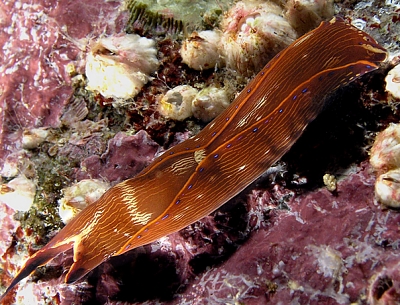

As a follow up to my earlier message [#20446], I wanted to share a color variation of Navanax. Am not sure if the brown version is a separate species. Is it?
And just for fun, here's a shot of a Navanax mighty close to a Cadlina flavomaculata. The Nav touched the slug, but passed up the snack.
Locality: Channel Islands, 40 feet, California, USA, Eastern Pacific, reefs. Length: 6cm ~ 8cm. Upper: 08 Sept 2005, Catalina Island, California
Middle: 06 Mar 2007, Catalina Island, California. Lower: 08 Jul 2007, Anacapa Island, California. Photographer: Kevin Lee.
K:-)
diverkevin@gmail.com
Kevin Lee, 2007 (Aug 16) More on Navanax inermis. [Message in] Sea Slug Forum. Australian Museum, Sydney. Available from http://www.seaslugforum.net/find/20447
Dear Kevin,
As with your earlier message, these photos all show the oral ridges very well. As you will see in Dave Behrens recent comments to Ken Tucker [#20188], the brown animal is just a colour form.
Best wishes,
Bill Rudman
Parasites and Navanax inermis
August 16, 2007
From: Kevin Lee
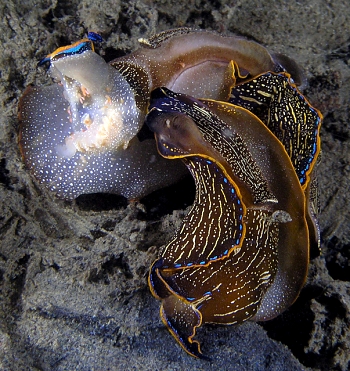
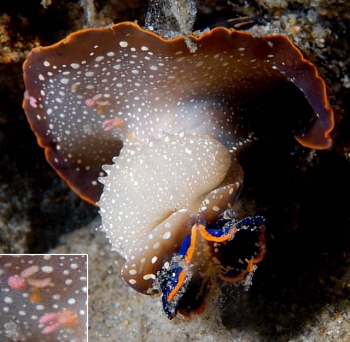
Bruce Wight's recent parasite post reminded me of some infestations I've witnessed on Navanax. I was was wondering if Navs, when afflicted with parasites, purposely "expose" themselves, [see middle photo] in the hope that a fish or crab might come by and clean off the offenders. I watched this Nav for five minutes and, all the while, it had its mantle flared out.
All three fotos were taken in La Jolla Canyon.
Locality: La Jolla, 65 feet, California, USA, Eastern Pacific. Upper: 03 Sep 2005. Middle: 27 July 2007. Lower: 15 Oct 2006. Sandy bottom. Length: 7 cm. Photographer: Kevin Lee.
Kevin Lee
diverkevin@gmail.com
Kevin L., 2007 (Aug 16) Parasites and Navanax inermis . [Message in] Sea Slug Forum. Australian Museum, Sydney. Available from http://www.seaslugforum.net/find/20446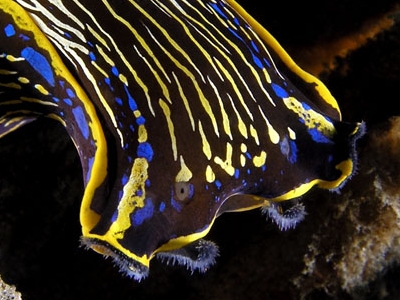
Dear Kevin,
I have looked at these photos rather hard and I think there is quite a bit of damage to the posterior end of the animals in the upper two photos. There are definitely copepods crawling over the skin but I think they are probably normal commensals.
In the upper photo there are two animals, the one on the right looks intact, but the one at the back seems to have the mantle organs missing - the shell, the gill, etc just aren't there. In the middle photo the 'flaring' bit at the top of the photo, with the copepods on it, is the foot, so the animal is upside down. The whitish 'sausage'-shaped structure in the middle is almost certainly the mucus gland section of the reproductive system, but that should be obscured by the large gill. Both the gill and the dorsal part of the posterior shield containing the shell appear to be absent. I think any 'itchiness' caused by the copepods is the least of these animal's concerns. My guess is there is something in the Canyon with a liking for the back end of Navanax. If you see an animal like this again try a bit of gentle poking and prodding to see if it is all there.
Thanks for the lower photo. One thing that does seem to differentiate Navanax from other aglajids are the elaboration of the pads on either side of the mouth which house the sensory bristles. In Navanax they have become curved ridges which are so clearly visible in your photo.
Best wishes,
Bill Rudman
Re: Navanax inermis mucus cocoon
August 15, 2007
From: Ernest Hartt
Concerning message #19140:
During my collections for my Master's research, I found many Navanax in mucus cocoons (which I reverently called "spit sacks"). They were generally inactive. Unfortunately, I was not collecting data on this, so my observations are only anecdotal, but I would estimate that close to 20% of the Navanax that I collected in Mission Bay, San Diego, CA, were in mucus cocoons. The cocoons were generally attached to eelgrass (Zostera marina ). Of the collections that I made in San Diego Bay, along Coronado Tidelands Park, I found them in cocoons less frequently, maybe between 5 and 10% of the time. I don't remember any mucus cocoons from my collections on the exposed, rocky shores of Swami's Point in Encinitas, CA. Collections were made 1989 and 1990, in ankle and waist deep water in both bay locations, during tides of -.5 feet or lower.
Locality: San Diego, 1 to 3 feet, California, USA, Pacific Ocean, 1989/1990, Intertidal Bays. Length: Various
Unfortunately we didn't take any pictures of the Navanax in their spit sacks.
Ernie Hartt
Lumikko@snail-mail.net
Hartt, E. W, 2007 (Aug 15) Re: Navanax inermis mucus cocoon. [Message in] Sea Slug Forum. Australian Museum, Sydney. Available from http://www.seaslugforum.net/find/20480Dear Ernie,
Although 'spit sack' probably won't win a place in a dictionary of biological terminology, thanks for the interesting observations. I certainly haven't seen it in any other aglajid so if anyone else has seen aglajids in cocoons like this, I would be interested in hearing about it.
Best wishes,
Bill Rudman
Might this be Navanax inermis?
August 14, 2007
From: Ken Tucker

Is this Navanax inermis? Looks quite similar, the lines are rather more broken than solid.
The photo was taken some time between 1994 and 1998.
Locality: Channel Islands, 20+ metres, California, USA, Pacific Ocean. Length: 5 cm. Photographer: Ken Tucker.
Ken Tucker
ken@kilili.com
Tucker, K.C., 2007 (Aug 14) Might this be Navanax inermis?. [Message in] Sea Slug Forum. Australian Museum, Sydney. Available from http://www.seaslugforum.net/find/20188Hi Ken,
Yes, your critter is indeed Navanax inermis. The coloration of this species varies quite a bit, from speckled to lined. The main give-away is that the speckles and spots always follow what one might call a broken line. Also the orange band along the edge of the mantle, followed by oblonged blue spots, pretty much nails the ID.
Best wishes,
Dave Behrens
Swimming Navanax from central California
August 6, 2007
From: Ron Eby
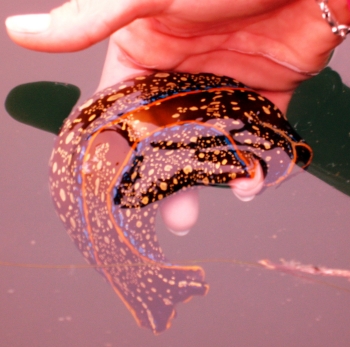
I'm attaching a picture taken 7/29/07 at Elkhorn Slough near Monterey, California. The specimen was found in the harbor about 1/4 mile from the entrance to the Monterey Bay. It was within inches of the surface and swimming. It was near a section of bull kelp which had obviously washed in with the tide, so it may have been more a passenger than a swimmer. Relative size can be determined by the hand in the picture.
Locality: Moss Landing North Harbor, near surface, California, USA, Pacific Ocean, 29 July 2007, Intertidal harbor. Length: 7 inches. Photographer: Ron Eby.
I'm part of a group that helps protect the Monterey Bay Sanctuary by greeting kayakers on the water, making sure they respect the mammals and unique marine environment we have here. The majority of our time is spent just chatting and providing information. We run a bulletin board http://www.orgsites.com/ca/teamocean/index.html for our volunteers and I have also posted a copy of this sea hare there. I think further identification would be of interest to them, so I appreciate your research.
Thanks,
Ron
ronaldeby@peoplepc.com
Eby, R. G., 2007 (Aug 6) Swimming Navanax from central California. [Message in] Sea Slug Forum. Australian Museum, Sydney. Available from http://www.seaslugforum.net/find/20368Dear Ron,
This is Navanax inermis. I must say I has never thought of this as a swimming species so if anyone with knowledge of this species can enlighten me on its swimming abilities I would be grateful.
Best wishes,
Bill Rudman
Navanax inermis laying eggs
July 28, 2007
From: Bruce Wight

Hi Doc,
Found a Navanax inermis laying egg, thought it might add value to the forum. See attached two images
Locality: San Miguel Island, 50 feet, California, USA, Pacific, 15 July 2007, Reef stucture. Length: 3 inches. Photographer: Bruce Wight.
Bruce Wight
bruce.c.wight@boeing.com
Wight, B.C., 2007 (Jul 28) Navanax inermis laying eggs. [Message in] Sea Slug Forum. Australian Museum, Sydney. Available from http://www.seaslugforum.net/find/20315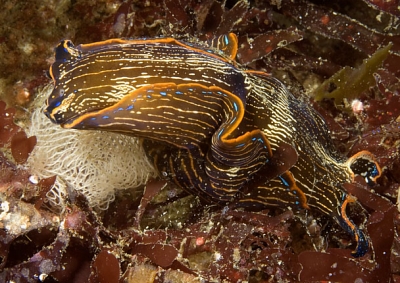
Thanks Bruce,
We have a number of photos of aglajids at various stages of egg laying on the Forum [see #15333 for example] but none for Navanax inermis. All aglajids seem to form the egg mass by winding the egg string around their head and then slipping it off their head (much like we can wind rope into a coil with our arm and shoulder) . Your photos seem to show that final stage where the egg coil has been slipped off the head and is anchored in the substrate by a mucous anchor.
Best wishes,
Bill Rudman
Navanax inermis mucus cocoon
May 23, 2007
From: Phil Garner
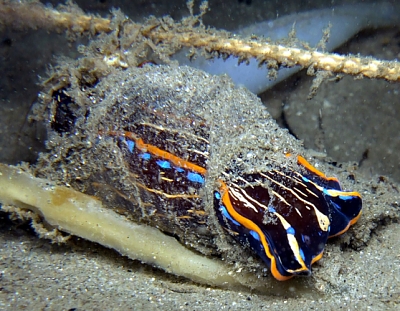
I noticed a mucus cocoon on a Navanax inermis at Redondo Beach, California last night. Do they secrete this for protection while sleeping the way Parrotfish do?
Locality: Redondo Beach, 80 feet, California, Pacific, 03 January 2007, Muddy bottom. Length: 3 inches. Photographer: Phil Garner.
Phil Garner
PacificCoast101@cox.net
Garner, P., 2007 (May 23) Navanax inermis mucus cocoon. [Message in] Sea Slug Forum. Australian Museum, Sydney. Available from http://www.seaslugforum.net/find/19140Dear Phil,
It certainly is an interesting thought to compare this 'cocoon' with the temporary mucus nest that Parrot Fish sleep in, but I don't think aglajids have a similar behaviour. Aglajids, like Navanax, have a cluster of large mucus glands at the front of the body which produce a continuous mucus tube through which the animal crawls, especially when it is burrowing through the sand. I suspect in this case that the animal has just emerged from the sand and hasn't quite sloughed off the sand-entangled mucus, or perhaps something has just washed it out of the sand - a current? or anchor? perhaps.
Best wishes,
Bill Rudman
Trail following in Navanax inermis
August 29, 2006
From: Ernest Hartt
Concerning message #17506:
While this doesn't concern Risbecia, I did examine trail following in Navanax inermis in my Master's thesis. Here are my observations in this area:
Trail Following
The possible influence of trail following on conspecific predation by N. inermis was evaluated with multiple regression analyses using data recorded for each encounter which took place throughout the study. Three regressions were performed, with cannibalism, the number of predation attempts in which the individual was the predator, and initiation of encounters as the dependent variables. The same independent variables were used in both regressions. They were water temperature, relative weight, collection site, feeding latency, pat dry wet weight, and trail following. Trail following was shown to be a significant factor in the initiation of encounters (regression p-value = 0.0001, factor p-value = 0.0001), and in the number of predation attempts in which the individual was the predator (regression p-value = 0.0001, factor p-value = 0.0001), but not for cannibalism itself (regression p-value = 0.0001, factor p-value = 0.3498). Those N. inermis that followed trails were more frequently the initiators of encounters, and of predation, but there was no significant effect on cannibalism by trail following.
Locality: San Diego, 3 cm, California, USA, Pacific Ocean, October 1989-September 1990, Laboratory. Length: various
Ernest Hartt
lumikko@snail-mail.net
Hartt, E. W, 2006 (Aug 29) Trail following in Navanax inermis. [Message in] Sea Slug Forum. Australian Museum, Sydney. Available from http://www.seaslugforum.net/find/17603Dear Ernie,
Thanks for the information. Are you planning to publish your results? Trail following in carnivorous aglajids, who are looking for prey, is a fairly understandable concept. However the trailing we find in sponge-feeding chromodorids, where conspecifics follow each other touching head to tail, is more difficult to understand. If you have any thoughts they would be most welcome
Best wishes,
Bill Rudman
Navanax - Aplysia interactions
April 7, 2006
From: William G. Wright
Dear Bill,
I have thoroughly enjoyed and appreciated Slug Forum for a long time, now, without properly registering my thanks. Thank you so much for your dedication to this amazing project.
I wanted to post a movie from my lab's web-site that shows a specimen of Navanax inermis attacking an individual of Aplysia californica.
http://www1.chapman.edu/~wwright/Predation.html
Locality: Chapman University; Orange, Intertidal, California, USA, Pacific, Spring, 2004, Rocky Intertidal. Length: 60 mm. Photographer: Andrew Duarte.
This Navanax was collected by an undergraduate, Erika Fujimoto, from the outer intertidal near Newport Beach, California. This is prime habitat for Aplysia. Andrew Duarte, another undergraduate in my lab, shot this amazing video sequence. Two observations are important here. First, the Aplysia is no bigger than the Navanax. Thus, its chances of survival are relatively small. Second, the Aplysia is naive. That is, it has never been attacked by a Navanax.
We have now staged a wide range of Navanax attacks on Aplysia, and find that the outcome is rarely as certain as this movie suggests. Size is critically important (larger Aplysia almost always escape), but even if the sizes are similar, the outcome varies substantially. Thus, for example, if the Navanax in this case had encountered the Aplysia from the side, the Aplysia would probably have escaped.
Even more interesting is the effect of the experienced of being attacked on Aplysia. Two other undergraduates in my lab, Amanda Rodriguez and Candace Thomas, have now shown that reflex withdrawal reflexes in Aplysia after once being attacked are enhanced by 50-200 percent. Thus, the experience of surviving a Navanax attack causes "sensitization", an increase in the amplitude of defensive withdrawal reflexes. This form of "learning" has been studied for several decades. Surprisingly, however, no one has until now demonstrated that a natural stimulus (researchers use various unnatural stimuli such as electric shock and wire brushes to induce sensitization) can cause sensitization. Candace and Amanda will present their data at this Fall's Society for Neuroscience Conference in Atlanta, and hopefully we'll have the paper ready soon thereafter.
Of course, the gold standard for an ecologist or evolutionary biologist would be to demonstrate that any behavioral change in an Aplysia that has survived a Navanax attack will actually improve the Aplysia's chances of survival in a second attack. We are presently hot on the trail of this gold standard. Notice in the movie that there is a complete lack of a withdrawal reflex in the Aplysia as it first comes into contact with the Navanax. An increase in the sensitivity to such contact would seem to be a likely first line of defense for a once-attacked, twice shy Aplysia. Stay tuned.
Bill Wright
Chapman University
Orange, California
wwright@chapman.edu
Wright, W. G., 2006 (Apr 7) Navanax - Aplysia interactions. [Message in] Sea Slug Forum. Australian Museum, Sydney. Available from http://www.seaslugforum.net/find/16251Dear Bill,
Thanks for this progress report. It's good to find out what research is going on with these fasinating animals which isn't anatomy and phylogeny. Not that there is anything wrong with anatomy and phylogeny but we anatomists can easily lead a blinkered existence without a bit of cross-fertilisation. I must say watching aglajids feed reminds me of a snake swallowing its prey.
I certainly look forward to updates.
Best wishes,
Bill Rudman
Navanax eating Aplysia
September 17, 2005
From: Brad Bartczak
In my Marine Biology class we were able to get a Navanax to eat an Aplysia, problem is this only happened once. I was wondering what the eating habits were, such as how often and how much.
Thank you,
Brad B.
Los Alamitos Bay, BA, California
Bart3401@aol.com
Brad Bartczak, 2005 (Sep 17) Navanax eating Aplysia. [Message in] Sea Slug Forum. Australian Museum, Sydney. Available from http://www.seaslugforum.net/find/14785Dear Brad,
A lot depends on the size of the Navanax and the size of its prey. I don'yt know off hand whetjer anyone has researched that very thoroughly. There are some nice studies on what they eat and how they catch their food which I list on the species Fact Sheet but I don't think any go into great detail. have a look at the other messages about Navanax on the Forum for futher information.
One article which whcih would be useful and easy to get hold of in California is:
Paine, R.T. (1963) Food Recognition and Predation on Opisthobranchs by Navanax inermis. The Veliger, 6(1): 1-9.
The Veliger is a scientific journal published in California so your local library, or museum or university should have a copy.
Best wishes,
Bill Rudman
Is this Navanax?
December 28, 2004
From: Peter McGuinness
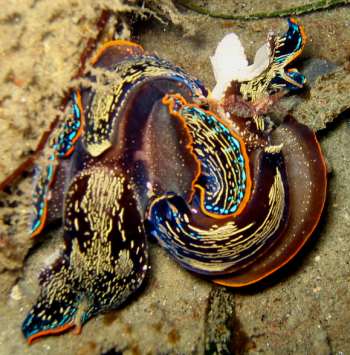
I photographed these two slugs earlier this year at La Jolla Shores, California. I think they are Navanax (enjoying a little hermaphroditic coupling) but I have not seen this exact coloring in any photos I have been able to find. Do you have any further information?
Locality: La Jolla Shores (Marine Room)
Depth: 60 ft
San Diego County, California, USA
Length: 4 inches
9 September 2004 , 7:00PM
Sand bottom at top of canyon slope.
Photographer: Peter McGuinness
Thanks,
Peter
pmcguinness@sbcglobal.net
McGuinness, P., 2004 (Dec 28) Is this Navanax?. [Message in] Sea Slug Forum. Australian Museum, Sydney. Available from http://www.seaslugforum.net/find/12838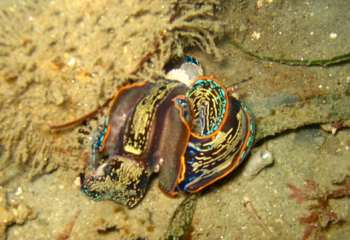
Dear Peter,
Yes this is Navanax inermis. It is quite variable in colour, and only one species is known from California. I think the white triangular object you can see at the back of the right animal is its gill, which is usually hidden beneath the mantle shield which encloses the fragile internal shell.
Best wishes,
Bill Rudman
Re: Strange lunch for Navanax
December 18, 2003
From: Ernie Hartt
Following on from your earlier comments I agree that Navanax don't seem to have any way of judging the size of their potential prey. In my master's research, I had one pair, both about 50 grams, in which one animal got the second about half-way down its gut, but could get it no further. At the end of my 3-hour observation period they were in the same position, so I "observed" them for another hour before returning them, still together, to a holding enclosure as I had to go to work, and my experimental protocol had been followed (they were observed in a 1 m square water tank, with flow through sea water about 10 cm deep, with natural bay sand substrate). I returned to the lab on my way home from work about 6 hours later to find the pair as I had left them. So I forcibly separated them, and put them in separate enclosures, even though the one that was being eaten did not look to be in good shape. But the next day, it was zipping around its enclosure, looking none the worse for wear.
I also had an attempt at cannibalism by an individual of less than 5 g on an individual if more than 100 g. Needless to say, the bigger Navanax reacted poorly, turned around, and gulped down the little guy, only to spit him back out for some reason.
Perhaps the strangest incidents were attempts at self cannibalism, which occurred while individuals were turning around; they at least demonstrate that Navanax can successfully follow slime trails to find prey, even if the prey is one's own tail!
Oh, and by the way, the gills on Navanax are posterior.
Ernie Hartt
Lumikko@snail-mail.net
Hartt, E., 2003 (Dec 18) Re: Strange lunch for Navanax. [Message in] Sea Slug Forum. Australian Museum, Sydney. Available from http://www.seaslugforum.net/find/11711Dear Ernie,
Thanks for sharing these observations with us. Observations like this are often made by students in the course of their research but often are never published. Although in themselves they don't seem to be important, if we are able to accumulate enough of them they could provide us with useful background information which might just provide a missing link in someone's research or suggest a valuable line of inquiry.
Concerning its gills. In aglajids, such as Navanax, the shell is very reduced in size and lies internally at the posterior end of the body. The shell and the mantle cavity are of course closely linked, and in aglajids the gill, anus and female reproductive openings are all situated in a very reduced mantle cavity, opening ventrally at the posterior end of the body, beneath the shell.
Best wishes
Bill Rudman
Strange lunch for Navanax
November 15, 2003
From: Bruce Wight
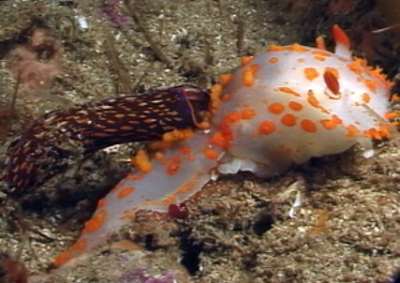
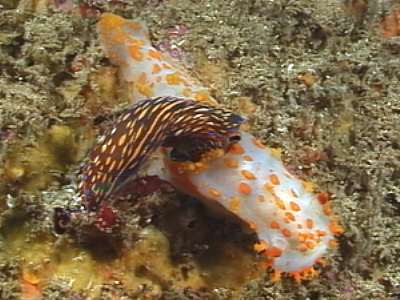
Dear Bill,
Check out the message and photos I received from Walter Marti. Do Navanax feed on Triopha?
"Shot this weekend [October 21, 2003] off of Santa Cruz Island [California, USA], with my video. I didn't stage this, or else I would have taped the strike.
Do you know what the process is? Will the Navanax just chew off a chunk, or will he suffocate the Triopha catalinae and then dine on. It seems that the Navanax has the gills in it's jaws. I filmed the Triopha moving about two feet. It was on top of a large rock and appeared to be running for shelter in the tight recess at the bottom of the rock.
At least now I know what flavor the Navanax likes. I'll work on staging the strike. ... Walter"
Bruce Wight
bwproductions@earthlink.net
Wight, B., 2003 (Nov 15) Strange lunch for Navanax. [Message in] Sea Slug Forum. Australian Museum, Sydney. Available from http://www.seaslugforum.net/find/11406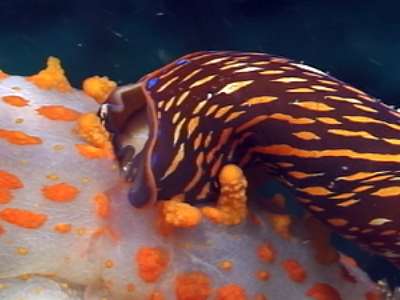
Dear Bruce [& Walter]
I am afraid the brains and beauty don't always go together and I'm afraid sea slugs have plenty of beauty but not much in the way of brains. The Triopha obviously 'felt' or 'smelled' like food to the Navanax. Unfortunately the Navanax has no way of making a judgement on what size prey is appropriate. As most aglajids lack teeth, and any other biting parts, they cannot eat an object they can't swallow whole. In this case the Triopha may be seriously 'gummed' but it unlikely to suffer any real damage.
I looked at feeding in Melanochlamys cylindrica which is an aglajid which feeds exclusively on polychaete worms which they eat by sucking in like a piece of spaghetti. It was often found intertidally in New Zealand on coralline algal turf and I often wondered why I often found them head down and tail up exposed at low tide until I discovered that sometimes when they were sucking in a worm it half escaped back into its burrow. Unable to bite off the piece it had swallowed, the aglajid was forced to stay anchored against the worm's burrow entrance until the part in its stomach was digested. Similarly when I fed animals in aquaria I would throw in some appropriately sized worms and if by chance two slugs tried to ingest the same worm - one at the head and one at the tail - invariably they would both suck in the worm until the two slug's heads met. They would then sit head to head for up to six hours until they digested the part they each had.
I guess therefore, that it is possible that your Navanax will hang on to the Triopha until the part it has ingested is digested
Best wishes
Bill Rudman
Navanax - yellow secretions
October 13, 2003
From: Tammy
Hi, and thank you for reading my questions. My Marine Biology class went to Naples Bay, Long Beach, California on Friday, October 10, 2003 and a Navanax was found. When one of the students put the Navanax into a bucket it left neon yellow mucousy stuff on his hand. The Navanax also put a good amount of yellow stuff in the bucket as well. When it was in the bucket with the water we could see some rows of whitish/yellowish stuff that looked like an internal organ of some type. I was wondering what part of its body it was.
Thank you,
Tammy
tcp1970@earthlink.net
Tammy, 2003 (Oct 13) Navanax - yellow secretions. [Message in] Sea Slug Forum. Australian Museum, Sydney. Available from http://www.seaslugforum.net/find/11210Dear Tammy,
Navanax inermis belongs to the bubble-shell family Aglajidae, and all members of the family produce this yellow ink you describe. Have a look at the Yellow Ink Page on the Forum for some more information. There is a drawing I did many years ago of the anatomy of Navanax showimg the yellow ink gland which opens alongside the anus at the rear of the body.
I guess the rows of whitish/yellowish stuff you describe are streaks of the yellow secretion mixed up with the white secretions all bubble shells can produce when disturbed. As you will see on the 'Yellow Ink Page' we aren't sure what the purpose of the Yellow Ink is, it is possibly just an excretory product.
Bbest wishes
Bill Rudman
Navanax inermis from Long Beach, California
April 30, 2003
From: Crystal
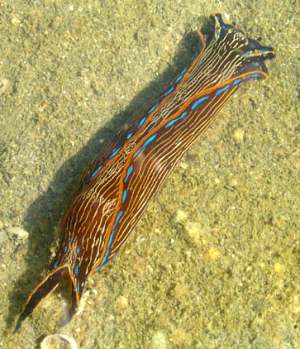
Hi,
I recently spotted this sea slug in Long Beach, California on the backside of the pennisula - not the ocean side. It was crawling along the sandy bottom in about 8 inches of water. It's about 4 inches long.
I would love to know it's name and a little more about it.
Thanks so much,
Crystal
crystal@dunniway.com
Dear Crystal,
This is Navanax inermis. It grows to about twice the size of your animal and is a voracious hunter, feeding on bubble shells and sometimes nudibranchs. Have a look at the species Fact Sheet and scroll down the page to see other messages about thhis species.
Best wishes,
Bill Rudman
Re: Navanax larval culture
March 21, 2002
From: Bill Rudman
In answer to Ivan and Alfonso's question about keeping Navanax larvae alive, I should have referred then to John Paige's paper on the laboratory culture of Sea Hares. In that he uses artificial sea water, but much of the methodology would be the same.
• Paige, J.A. (1986) The laboratory culture of two Aplysiids Aplysia brasiliana Rang, 1828 and Bursatella leachi plei (Rang, 1828) (Gastropoda: Opisthobranchia) in artificial seawater. The Veliger, 29(1): 64-69.
Best wishes,
Bill Rudman
Larval development of Navanax
March 19, 2002
From: I.M. Loeza & A.M. Ortiz
We are studens of marine science in Ensenada, Baja California, Mexico. We found a specimen of Navanax inermis and it laid eggs. At this time we already have the free living velliger larvae, but we still need some information about how to care for them. It would be great if you could help us any way you can.
We'll wait for your answer.
Ivan Mendez Loeza and Alfonso Medellin Ortiz.
Facultad de Ciencias Marinas.
Universidad Autonoma de Baja California. Mexico.
Carretera Ensenada - Tijuana km. 103.
e_iml@hotmail.com
amedellin_79@hotmail.com
Loeza, I.M. & Ortiz, A.M., 2002 (Mar 19) Larval development of Navanax. [Message in] Sea Slug Forum. Australian Museum, Sydney. Available from http://www.seaslugforum.net/find/6454Dear Ivan and Alfonso,
There are some references to aspects of the natural history of Navanax inermis on the attached Fact Sheet but I am not sure if anyone describes looking after the larvae. I suspect this species has planktotrophic larvae which means trouble!
It's not impossible, but it means setting up a system which includes breeding up sterile cultures of particular species of phytoplankton for the veliger larvae to eat. The other thing that needs to be dealt with is the tendency for the larvae to get caught in the surface film. Perhaps someone can give us some ideas, or direct us to a site where methods for keeping larvae alive are discussed.
Best wishes,
Bill Rudman
More photos of Navanax inermis
July 29, 2001
From: Daniel Geiger

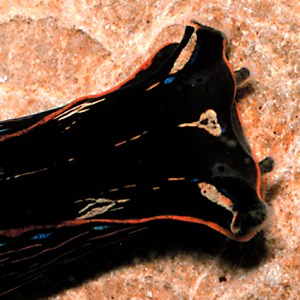
Dear Bill,
Here are a couple more photos showing colour variation in Navanax inermis. The lower photo shows the head of a particularly dark animal. You can see the finfer-like mound on either side of the mouth which are covered in sensory bristles which Navanax uses to follow the mucus trail of its prey.
UPPER: USA, California, Los Angeles County, Catalina Island, Big Fisherman Cove, Wrigley Institute, 26-27 May 2001, 5-8 m depth.
LOWER: USA, California, Los Angeles, Palos Verdes, Flat Rock: 26 December 1993
Daniel Geiger
dgeiger@nhm.org
Geiger, D., 2001 (Jul 29) More photos of Navanax inermis. [Message in] Sea Slug Forum. Australian Museum, Sydney. Available from http://www.seaslugforum.net/find/4931Thanks Daniel,
Bill Rudman
Some photos of Navanax inermis
July 27, 2001
From: Daniel Geiger
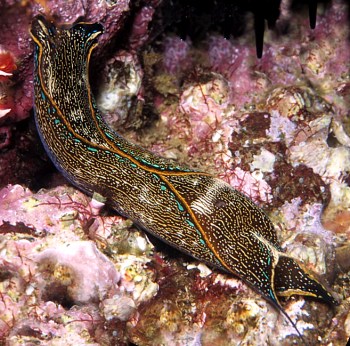
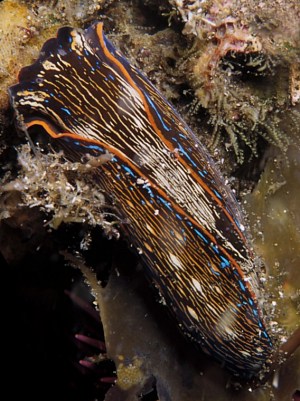
Dear Bill,
Here are some photos of Navanax inermis for the Forum. They were taken at West Anacapa Island, Channel Islands National Park, California, in 8-10 m., 5 July 2001. The animals were both about 5cm long.
Best wishes,
Daniel Geiger.
dgeiger@nhm.org
Geiger, D., 2001 (Jul 27) Some photos of Navanax inermis. [Message in] Sea Slug Forum. Australian Museum, Sydney. Available from http://www.seaslugforum.net/find/4927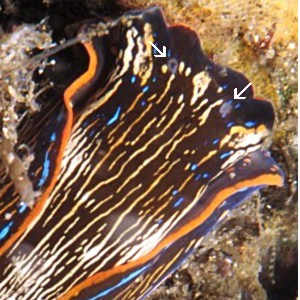
Dear Daniel,
I am glad to get some good photos of this wonderful animal. When I studied the anatomy of the aglajids as a graduate student I was fascinated by the size of this enormous animal. Growing to over 20cm, it is so much larger than most of its relatives. I have included a close-up of the head showing the clear patches through which the small black eyes can be seen. These eyes, as of course you will know, are very primitive light sensing organs, unable to form images and of no value in hunting its prey.
Best wishes,
Bill Rudman
Predators of Navanax inermis
March 10, 2001
From: Shannon
I'm doing a school report on the Navanax inermis. I was hoping that someone would be able to tell me some of the predators of this creature. Are the predators the same as the Hair Slug? Thanks for taking the time to read this.
Shannon
ShanDOdoubleG@aol.com
Shannon, 2001 (Mar 10) Predators of Navanax inermis. [Message in] Sea Slug Forum. Australian Museum, Sydney. Available from http://www.seaslugforum.net/find/3923Dear Shannon,
I have started a special page for information on what eats sea slugs. It is not easy to find this sort of information. I am not sure if there is any information on what attacks Navanax. Ernie Hart's message showed that they are sometimes cannibals, juvenile Navanax sometimes being eaten by larger Navanax. Perhaps someone can give us some more information. I guess you've had a look at the other messages on Navanax below yours on this page for some more background information. I'm sorry but I don't know which slug you mean by the 'Hair Slug'.
Best wishes,
Bill Rudman
Cannibalism in Navanax inermis
February 19, 2001
From: Ernie Hartt
In response to Scott Johnson's message on cannibalism in Gymnodoris citrina, I would like to bring to your attention work I have done on cannibalism in Navanax inermis. The scientific journals had lots of anecdotal mention of Navanax cannibalism, but no real studies, so I picked that as my Master's research. In a nutshell, I found that while larger Navanax tend to be more successful at cannibalistic attempts, they are not as likely to initiate them as small individuals. The larger, reproductively active individuals would engage in cannibalism, but only occasionally. With over 600 encounters between 300 individuals, there were fewer than 25 cannibalisms.
Ernie Hartt
Lumikko@eudoramail.com
Hartt, E., 2001 (Feb 19) Cannibalism in Navanax inermis. [Message in] Sea Slug Forum. Australian Museum, Sydney. Available from http://www.seaslugforum.net/find/3727Dear Ernie,
Thanks for the information. Your brief account certainly raises lots of questions in my mind. Most importantly, are you planning to publish your results? I hope so. Secondly, were your observations field observations, and if so were the encounters that led to acts of cannibalism, chance encounters or did one animal hunt the other down?
Best wishes,
Bill Rudman
Navanax diet
January 27, 2001
From: Vincent A. Parsick III
I have a Navanax in my aquarium, it co-exists perfectly with my Moray's, Lion Fish, Hermit Crabs, snails and Clown Fish, however it never seems to eat. What do these things feed on, and where can i get the food? I've tried algae, fish food, reef strogonof and lance fish, but it just slithers right over all of it, in some non successful hunting mission!
Please reply soon, as its been about two months that my poor navanax has been starving!
San diego diver
Vince Parsick
P.S. do you have any jobs in the San Diego area? I love marine biology, scubadiving, and sea life observation, and collecting!
Vince Parsick
PROSPECTPHOTO@SPRYNET.COM
Parsick, V., 2001 (Jan 27) Navanax diet. [Message in] Sea Slug Forum. Australian Museum, Sydney. Available from http://www.seaslugforum.net/find/3635Dear Vince,
In nature, Navanax inermis feeds on other sea slugs - such as bubble shells and sometimes nudibranchs. If you have a look at the top of this page you will see a link to Rhanor Gillette's website where there is a short video clip showing Navanax feeding.
On rocky shores it tends to feed on nudibranchs such as Hermissenda crassicornis, Polycera atra and Dirona picta, but I understand they are not that fussy. On sheltered muddy or sandy bottoms it feeds on bubble shells such as Haminoea virescens and Bulla gouldiana. I don't have photos of either species on the Forum but have a look at the photos of Bulla ampulla and Haminoea ovalis, which are both similar in shape, although Haminoea ovalis is much more brightly coloured than H. virescens.
Hope that gives you some clues on what to feed it. Concerning your job application. The world wide web is definitely worldwide. I live and work in Sydney, Australia, so I am afraid I have no jobs available in the San Diego region, or anywhere in California for that matter.
Best wishes,
Bill Rudman
Navanax inermis
October 3, 1998
From: Erwin Koehler
Dear Bill,
I hope you are getting better soon and paid as well as a heart doctor...
My question:
At http://www.ncups.org/RBrown.htm
are two Navanax inermis (as I guess) what is the thing they've got at their back, looking like gills?
Best wishes
Erwin
Erwin Koehler
Medslugs.Koehler@t-online.de
Koehler, E., 1998 (Oct 3) Navanax inermis. [Message in] Sea Slug Forum. Australian Museum, Sydney. Available from http://www.seaslugforum.net/find/244
Dear Erwin,
I have copied, with permission, Reggie Brown's photo of two animals mating. (Arrows point to the head of each animal.) [Copied with permission from his Northern Californian Underwater Photographic Society website].
The two animals in the picture are mating. The arrows point to the their heads. I'm not sure what part of the animal you are asking about. If it is the creamy white "finger-like" pattern you can see halfway down the back of the animal on the right then that is just a colour pattern at the posterior tip of the "anterior shield". The gill in aglajids is hidden under the enclosed shell at the posterior end of the body. .. Bill Rudman.
Rudman, W.B., 1998 (Oct 3). Comment on Navanax inermis by Erwin Koehler. [Message in] Sea Slug Forum. Australian Museum, Sydney. Available from http://www.seaslugforum.net/find/244